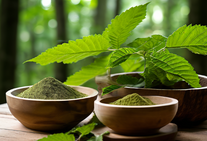Posted by Masterpiece Alternatives on 27th May 2024
Exploring the World of Kratom: Unveiling the Secrets of Mitragyna Speciosa (Part 1 of 5)
Greetings, and welcome to this captivating five-part series where we embark on an adventure to explore the wonders of Mitragyna Speciosa. Whether you're new to kratom or seeking to deepen your knowledge, this blog is here to be your trusted guide. Join me as we delve into the enchanting world of kratom, unravel its mysteries, and unlock its secrets. So, grab a cozy spot, relax, and let's embark on this fascinating journey together.
What is Kratom?
First things first, let's understand what kratom is all about. Mitragyna Speciosa, commonly known as kratom, is a tropical evergreen tree belonging to the coffee family. It is native to Southeast Asia, specifically Cambodia, Thailand, Indonesia, Malaysia, Myanmar, and Papua New Guinea. For centuries, the leaves of this remarkable tree have been used in traditional herbal medicine, tracing back to at least the 19th century.
Let's dive into some more detail about the alkaloid profile of kratom, specifically Mitragynine. Mitragynine is one of the primary alkaloids found in kratom leaves and is known for its stimulating effects on our opiate receptors. It interacts with the mu-opioid receptors in our brain, much like traditional opiates, but with a different mechanism of action. This interaction is what contributes to the unique effects that kratom can produce.
When mitragynine binds to the mu-opioid receptors, it can stimulate them to varying degrees, leading to effects such as pain relief, relaxation, and mood enhancement. However, it's important to note that kratom's alkaloid profile is complex and consists of multiple alkaloids, each with its own properties and effects.
In addition to mitragynine, another notable alkaloid found in kratom is 7-hydroxymitragynine. This alkaloid has been found to be even more potent than mitragynine and is believed to contribute to kratom's analgesic (pain-relieving) properties.
It's worth mentioning that while kratom's alkaloids can interact with our opiate receptors, kratom itself is not classified as an opiate. Opiates are derived from the opium poppy plant, while kratom comes from the Mitragyna Speciosa tree.
As with any substance, it is crucial to exercise caution and use kratom responsibly. Understanding the alkaloid profile of kratom can help individuals make informed decisions and better understand its potential effects.
Types of Kratom:
Now that we know the basics, let's delve deeper into the fascinating world of kratom and explore its different types. Kratom comes in various strains, each offering unique properties and effects. The three main types of kratom are White Vein, Green Vein, and Red Vein. These distinctions are based on the maturity of the leaves at harvest time, similar to tea. Just like how white tea is made from the youngest leaves and black tea from fully mature leaves, White Vein Kratom is harvested from the youngest leaves, while Red Vein Kratom comes from leaves that have reached full maturity. The maturity of the leaves contributes to the distinct and unique effects associated with each vein color. Additionally, there are also extracts available that provide a more concentrated form of kratom. Let's continue our exploration of these different types to uncover their specific characteristics and benefits.
Benefits of Kratom:
Kratom has gained popularity for its range of potential benefits. One of the key advantages is its mood-boosting and energizing properties. Many individuals find kratom to be a natural pick-me-up, offering mental clarity and focus. It can be a fantastic tool to kickstart your day and enhance productivity.
Another remarkable aspect of kratom is its potential for pain relief. If you're ready to explore alternative options to opiate-based medications and seek natural relief for your pain, kratom may be a suitable choice for you. With its potential for pain relief, including in cases of serious chronic pain associated with conditions like fibromyalgia, kratom offers a promising alternative. Whether you're dealing with migraines, minor pains, or even period cramps, kratom has shown its potential to provide relief without causing excessive sedation. Take a step towards safer and natural pain management with kratom.
A Rich History and Diverse Forms:
Kratom has a fascinating history deeply rooted in Southeast Asian cultures. It has been an integral part of traditional practices for centuries, passed down through generations. Its origins and the diverse ways it has been used make kratom a captivating subject of exploration.
In terms of forms, kratom is available in various options to suit different preferences. You can find kratom in the form of leaf powder, leaf powder capsules, and extracts. Additionally, there are beverages, shots, tinctures, and even edibles like gummies and chocolates infused with kratom. The possibilities are endless!
With our introduction to kratom complete, we have only scratched the surface of this intriguing plant. In the upcoming blogs, we will delve deeper into the specific strains of kratom, exploring the unique qualities and effects they offer. From the energizing White Vein to the well-balanced Green Vein and the soothing Red Vein, there is so much more to discover.
So, join us on this thrilling journey as we continue to explore the world of kratom. Unveiling its secrets and understanding its potential benefits is just the beginning. Together, let's navigate the enchanting realm of Mitragyna Speciosa and unlock the wonders it holds. Stay tuned for the next part of our series where we dive into the captivating world of White Vein kratom!
Continue your learning journey in our 5 part series, linked below:
Part 2: White Vein Kratom: Unleashing the Power of Clean Energy and Mental Focus
Part 3: Green Vein Kratom: Embrace the Balance of Energy and Upliftment
Part 4: Red Vein Kratom: Unleashing the Power of Tranquility and Pain Relief
Part 5: Kratom Extracts: Unveiling the Potency and Versatility
These statements have not been evaluated by the Food and Drug Administration (FDA). Kratom is not intended to diagnose, treat, cure, or prevent any disease. The information provided is based on anecdotal evidence, personal experiences, and traditional use of kratom.



